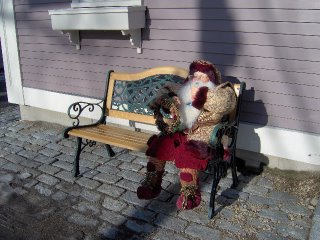The 11/21/05 issue of
The New Yorker includes an essay by
Adam Gopnik entitled "
Prisoner of Narnia" (pp. 88-93). It's an interesting piece -- the arguments are largely made by means of derogatory adjectives rather than by logic, reason, or evidence.
For me, the general tenor of the essay is shown by Gopnik's choice of analogies. I noticed two in the essay. He compares Oxford dons to "girls in a lap-dance club" (p. 90) ... because both allegedly adopt personas that are caricatures of themselves to help them deal with other people. And he compares Christians to "chronic sinus sufferers" (p. 92) ... because both allegedly compare notes on the state of something that interests them. I have stated these propositions as neutrally as I can so that readers may judge for themselves the usefulness of the analogies. It looks to me like the analogies were chosen mostly as a means to associate Oxford dons with sleaziness and Christians with sick people, but perhaps they were chosen just to show Gopnik's cleverness in finding similarities between wildly dissimilar groups.
After carefully reading the essay, I believe many of Gopnik's claims are unsupported, or miss the point entirely, or are just plain wrong. (Some of this is fairly subtle - Gopnik is right, of course, that C.S. Lewis was never a saint; but the point he is trying to make would be a hell of a lot more persuasive if he showed that C.S. Lewis's behavior stayed the same or got worse after his conversion.)
In this post, I will address a few of Gopnik's claims.
"Keep your belief going, no matter what it takes" (p. 92)
Gopnik states: "A startling thing in Lewis's letters to other believers is how much energy and practical advice is dispensed about how to keep your [sic] belief going.... Keep your belief going, no matter what it takes -- the thought not occurring that a belief that needs this much work to believe in isn't really a belief but a very strong desire to believe." (p. 92)
There is no need to be "startled" by Lewis's emphasis on the importance of maintaining one's faith, as Lewis's point is rather more nuanced than Gopnik lets on. In fact, Chapter 11 of Lewis's book
Mere Christianity addresses this point directly.
Lewis did
not take the position that one must maintain one's belief "no matter what" -- to the contrary, he expressly recognized that "if [a person] thought the evidence bad but forced himself to believe in spite of it, that would be merely stupid." And a person whose "reason once decide[d] that the weight of the evidence is for [Christianity]"
must reconsider the evidence if "any real new reasons against Christianity turn up." Contrary and inconvenient evidence cannot be ignored, but "ha[s] to be faced."
So what must a believer's faith be defended against? Lewis's answer may be a bit shocking to people who have accepted a cartoonish version of Christianity (equally prevalent in children's Sunday school classes and in the media): Lewis states that "The battle is between faith and reason on the one side and emotion and imagination on the other." I find two of Lewis's examples intriguing.
"For example, my reason is perfectly convinced by good evidence that anaesthetics do not smother me and that properly trained surgeons do not start operating until I am unconscious. But that does not alter the fact that when they have me down on the table and clap their horrible mask over my face, a mere childish panic begins inside me. I start thinking I am going to choke, and I am afraid they will start cutting me up before I am properly under. In other words, I lose my faith in anaesthetics. It is not reason that is taking away my faith: to the contrary, my faith is based on reason."
"Or take a boy learning to swim. His reason knows perfectly well that an unsupported human body will not necessarily sink in water: he has seen dozens of people float and swim. But the whole question is whether he will be able to go on believing this when the instructor takes away his hand and leaves him unsupported in the water -- or whether he will suddenly cease to believe it and get in a fright and go down."
C.S. Lewis,
Mere Christianity, Chapter 11.
Lewis is not the only one to have noticed this phenomenon, either. Phil Keoghan (the force behind the television show
The Amazing Race) describes his experience finding himself lost and alone in a shipwreck when scuba diving at 19 (with another scuba diver and a camera crew nearby who knew he was somewhere in the wreck):
I was riding a kind of emotional seesaw: One moment I was up high, reassuring myself that "it's okay, someone will show up soon, just stay calm." The next moment, I felt myself descending to the bottom of the seesaw, the dark side where reason gives way to panic, and where doubt ("How do you know anyone's coming back?") overrides faith.
Phil Keoghan,
No Opportunity Wasted, Chapter 1. (Keoghan notes that doubt and panic ultimately triumphed in his case - ironically, that stresses the air respirator system and depletes one's air supply more rapidly - and that he soon slipped into unconsciousness. He was nonetheless rescued and returned with a new zest for life, a drive to
make every moment count.)
"Aslan the lion, the Christ symbol, ... is ... in many ways an anti-Christian figure" (p. 92)
Gopnik does raise an interesting point about differences between Aslan and Jesus Christ. He notes, correctly, that Aslan comes in power and glory as the king of the beasts and "the top of the food chain" rather than in humility. (p. 92) He further posits that "[i]f we had, say, a donkey ... rallying the mice and rats and weasels and vultures and all the other unclean aminmals, and then being killed by the lions in as humiliating a manner as possible -- a donkey who reemerges, to the shock even of his disciples and devotees, as the king of all creation, now
that would be a Christian allegory." (
Id. (emphasis in original))
This argument proves too much. Obviously any comparison (including Gopnik's own colorful analogies as well as Lewis's Christian allegory) contains points of similarity
but also points of difference -- otherwise it would not be a comparison but a mere reiteration.
The redemption scenario in
The Lion, the Witch and the Wardrobe is not directly parallel to the Christian story. It is not meant to be. For instance, Aslan dies for
just one sinner (Edmund) rather than for the whole world, and Aslan's sacrifice is apparently a secret (it is not clear that Edmund ever learns of it; only Lucy and Susan see Aslan's humiliation, suffering and death, and Susan's view that "[i]t would be too awful for [Edmund]" if he were told of it prevails). (ch. 17) I am not sure why Lewis made these choices, except that it may be easier for children to grasp the concept of Christian sacrifice writ small (for one person who has clearly done something terribly wrong) rather than going into the more complex Christian concept that
all of us -- even "good" people -- are sinners desperately in need of redemption.
So, why
did Lewis make Aslan a powerful lion rather than a humble donkey? Well, why stop there? If we take Gopnik's argument a little further, perhaps Lewis should have made Aslan a mouse, or a cockroach, or a speck of dust? By exaggerating (and yes, mocking) Gopnik's point we can see some of the reasons why Lewis chose a lion.
For instance, making Alsan a lion emphasizes the extent of the sacrifice Aslan made for Edmund: the humiliation of a proud and powerful lion is more likely to evoke pity and horror in children than the humiliation of a donkey (or a mouse or cockroach, for that matter). Presumably Lewis wanted children to like and admire Aslan so that his death would have more impact.
There is perhaps a more subtle point here as well. A typically Christian view is that (i) God is the rightful sovereign of the universe and (ii) the entire trinity (father, son and holy spirit) consitutes just one God (not three separate gods). So it makes sense to make the Christ figure a lion -- widely considered the "king of the beasts" -- in order to emphasize that he is the
rightful sovereign of Narnia ... even though the evil one has claimed the crown. Lewis chose to emphasize the glory of God; as Kathy Keller has noted, there is certainly biblical precedent for this. [Updated 3/8/2015 to remove non-functional link. Her article is currently available at
http://www.redeemer.com/redeemer-report/archive-pdfs, go to "2005 Newsletters" and select "December 2005."]
The Narnia stories are racist (p. 88)
With apparent approval, Gopnik notes in passing that "the wonderful British fantasist Philip Pullman has excorciated [the Narnia stories'] racism (the ogres are dark-skinned and almond-eyed)". (p. 88) Gopnik does not marshal any further evidence for or against this point in the rest of the article, leaving Pullman's charge to dangle before the reader without analysis.
If it is evidence of racial bias that the evil ogres are "dark-skinned and almond-eyed" (there is no citation for this point, but we will assume for the moment that this description is actually found somewhere in the Chronicles of Narnia), then it can surely be disproved by a showing either that (i) some dark-skinned characters in the Narnia stories are good or (ii) some light-skinned characters are evil.
As it turns out, we need look no further than
The Lion, the Witch and the Wardrobe to disprove the charge:
- The most evil character in the book (the devil figure, if you will) is the person who has set herself up as "Queen of Narnia" in Aslan's absence. Here is how she is described: "Her face was white -- not merely pale, but white like snow or paper or icing-sugar, except for her very red mouth." (ch. 3) So the race of the most evil character is unmistakably Caucasian.
- And what of the other side -- what does good look like in Narnia? Well, Aslan is (like all lions) "golden" in color (e.g., ch. 12), which somewhat defies categorization in terms of human racial characteristics. But it is perhaps worth noting that as good starts to triumph over evil, "[i]nstead of all that deadly white the courtyard was now a blaze of colors; glossy chestnut sides of centaurs, indigo horns of unicorns, dazzling plumage of birds, reddy-brown of foxes, dogs and satyrs, yellow stockings and crimson hoods of dwarfs; and the birch-girls in silver, and the beech-girls in fresh, transparent green, and the larch-girls in green so bright that it was almost yellow." (ch. 16)
In fact, when good is ascendant in Narnia, there is tremendous, jubilant diversity, a veritable riot of both color and sound (like a
Gay Pride parade without the eroticism). The Narnians, once liberated, are running, dancing, cavorting, shouting, singing, and laughing with joy. (ch. 16)
I fear it is not Narnia that is "nasty" and "narrow-hearted" in this regard (p. 88), but rather our friend Pullman.
 Presents were exchaged. This was a novelty for my niece, who really wasn't paying a whole lot of attention on her previous (first-ever) Christmas. This time, she was more aware of what was going on and was delighted with her own gifts as well as others' gifts. She particularly enjoyed a set of 12 tea candles I gave to her mom (my sister-in-law) -- endless opportunities to open and close the tin, remove and arrange the tea candles by color or otherwise, remove and replace the clear plastic covers, etc.
Presents were exchaged. This was a novelty for my niece, who really wasn't paying a whole lot of attention on her previous (first-ever) Christmas. This time, she was more aware of what was going on and was delighted with her own gifts as well as others' gifts. She particularly enjoyed a set of 12 tea candles I gave to her mom (my sister-in-law) -- endless opportunities to open and close the tin, remove and arrange the tea candles by color or otherwise, remove and replace the clear plastic covers, etc. No, it is not the three starfish over the door (although they are pretty cool). Look carefully -- you will note that there is some snow on the front steps. But the window sills and greenery (green in December, in New England?!) are completely free of snow.
No, it is not the three starfish over the door (although they are pretty cool). Look carefully -- you will note that there is some snow on the front steps. But the window sills and greenery (green in December, in New England?!) are completely free of snow.

 Even Santa got a little disoriented, and stopped to rest on this bench.
Even Santa got a little disoriented, and stopped to rest on this bench. Despite the unseasonably mild weather, however, the Piscataqua Cafe is not open. Then again, it is no longer a cafe or hotel, but an unheated guest cottage to a private home. I hear a rumor that they do have indoor plumbing now, unlike the bad old days when they took in paying guests....
Despite the unseasonably mild weather, however, the Piscataqua Cafe is not open. Then again, it is no longer a cafe or hotel, but an unheated guest cottage to a private home. I hear a rumor that they do have indoor plumbing now, unlike the bad old days when they took in paying guests.... All in all, it was a peaceful and serene time. I really liked this typical rocky New England coast line, complete with lighthouse.
All in all, it was a peaceful and serene time. I really liked this typical rocky New England coast line, complete with lighthouse.









































